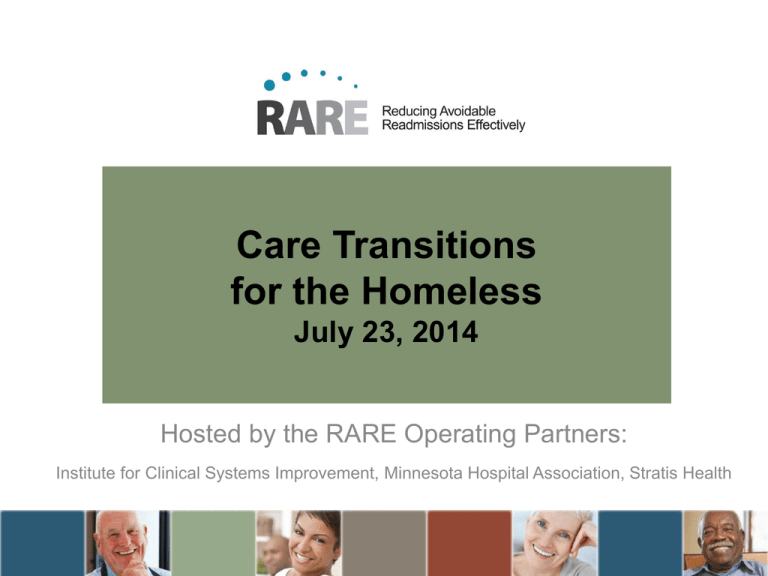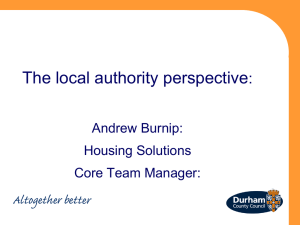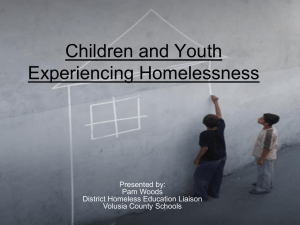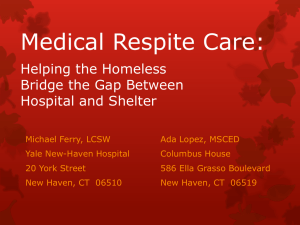Slides
advertisement

Care Transitions for the Homeless July 23, 2014 Hosted by the RARE Operating Partners: Institute for Clinical Systems Improvement, Minnesota Hospital Association, Stratis Health Our host’s today will be… Kathy Cummings, RN, BSN, MA Project Manager, ICSI Jill Kemper, MA Project Manager, ICSI Webinar Objectives • 1. To learn about programs and resources focused on care transitions for the homeless. • 2. To understand the challenges in working on care transitions for the homeless. • 3. To learn about opportunities to connect with others working on care transitions for the homeless in Minnesota. Why RARE Conversations? Share Networking opportunities Engage Learn Conversation July’s Conversation… Care Transitions for the Homeless Sharing their work: Minnesota Department of Human Services, Catholic Charities, Guild Incorporated and Hearth Connection More about the presenters… Julie Grothe Dawn Petroskas Kristine Davis John Petroskas Kelby Grovender Building the case for medical respite care for homeless adults John Petroskas Minnesota Department of Human Services John.Petroskas@state.mn.us What is Medical Respite Care? “Medical respite care is acute and post-acute medical care for homeless persons who are too ill or frail to recover from a physical illness or injury on the streets but are not ill enough to be in a hospital.” National Healthcare for the Homeless Council Lots of respite info and a short video: http://www.nhchc.org/resources/clinical/medical-respite/ Medical respite is valuable • Respite programs are an important part of the homeless service continuum. • Respite care is an effective intervention, offering recovery from illness or injury as well as connections to housing, primary health care, disability benefits, treatment, and supportive services. • Medical respite programs are cost effective. Respite Planning Process January 2003: MESH convenes 1st community provider mtg. June 2003: One-day needs survey is conducted March 2004: Minneapolis Foundation planning grant September 2004: Hennepin County Healthcare for the Homeless Project receives Medica Foundation startup funds Early 2005: 20-bed respite program for homeless men begins at Salvation Army Harbor Light shelter Today: respite program continues to serve homeless patients suffering from acute illness or injury Community Provider Meetings • Monthly meetings for nearly two years • Staff from more than 20 agencies participated: shelters, hospitals, clinics, outreach programs, drop-in centers, and metro counties. • We sought to develop a respite service model that would meet the needs of homeless people in the Twin Cities. Needs Survey • • • • Conducted on a single day (June 16, 2003) Simple one-page survey instrument 65 sites agreed to participate Objective: learn how many acutely ill or injured single homeless adults would benefit from temporary respite shelter, if available. Survey Results • • • • • • 77 surveys returned 35 most-likely respite candidates identified 70% men, 30% women Average age: 42 (range 18-63) Most were insured Most frequent sites of medical care were HCMC (46%) and Regions (11%) Survey Results • Most common conditions: post-surgical recovery, orthopedic injuries, pneumonia, burns, cellulitis, back injuries, renal failure, ear/nose/throat illnesses • Most common needs: rest (60%), medication management (30%), dressing changes (20%), care coordination (14%) • Most needed only brief period of respite care Wilder Homelessness Survey • Added question to 2003 statewide survey • 24.7% of those who visited an ER in the last six months said they had been released with instructions they couldn’t follow because of their homelessness • 8.7% of all homeless adults surveyed Transitional Recuperative Care Dawn Petroskas, RN, PhD Director of Health Services Catholic Charities of St. Paul and Minneapolis July 23, 2014 Transitional Recuperative Care Pilot • January 1, 2012 to January 1, 2013 • Funded by Medica Foundation and North Memorial • Provide safe and dignified space for homeless people being discharged from the hospital to recover from acute illness/injury or stabilize from an exacerbation of a chronic condition. Pilot Goals • Improve patient health outcomes • Promote patient’s human right to health and dignity • Decrease recidivism Transitional Recuperative Care Patient Usage of Hospital-Based Services (14 Patients) 90 80 84 70 60 Year Prior to TRC Admission 50 Year Following TRC Admission 40 40 30 20 21 10 7 0 ER Visits Hospital Admissions 18 Estimated Avoidable Health Care Costs 4/13/2015 19 Exodus Health Supported Housing/TRC 819 2nd Ave. S Minneapolis 20 Who We Serve • Patients range from 25 to 82 years old - 60% are over 50 • Over 30% come with equipment needs (e.g. oxygen, catheters, walkers, colostomy, laryngeal device) • Mental Illness – 50% Chemical Dependency – 40% • 46% are people of color • Patients are referred from: Hennepin County Health Care for the Homeless (30%) Hennepin County Medical Center (20%) Hennepin Health (18%) North Memorial Health Care (17%) Mental Health Facilities (6%) Shelters (4.5%) Community (4.5%) 4/13/2015 23 Research & Evaluation • Respite Care: Effects on the Perceived Health & Health Care Utilization of Homeless Adults – University of MN - Center for Health Equity in Clinical and Translational Science Institute • Medical Respite Care for People Experiencing Homelessness – National Health Care for the Homeless Council 4/13/2015 24 Thank You! dawn.petroskas@cctwincities.org 651-647-3127 Hospital to Home: Alternative Interventions Leading to Stable Housing & Reduced Use of Emergency Departments About Guild Not-for-profit, accredited community mental health provider with roots in the early 1970’s Exists to help people with mental illness lead quality lives Service Lines: In 2013 the agency served over 2,300 individuals across all service lines. Community Treatment Assertive Community Treatment, Mobile Integrated Case Management and Care Coordination Teams Residential Services / Supportive Housing Intensive Residential Treatment Crisis Stabilization Delancey Services Specialized, intensive, mobile team services for people experiencing chronic homelessness compounded by mental illness, substance abuse, trauma & violence Supported Employment Services Project Partners Key Questions Project Partners agreed to answer the following questions as a way to address costs as well as service provisions: Can a hospital identify its highest cost patients who also have long histories of homelessness? Can a health care system and a supportive housing organization partner to create an intervention that links care management and supportive housing? Would such an intervention lead to better care and reductions in hospital admissions, length of stay and emergency department visits? Is there a way to re-invest savings into supportive housing interventions for this population? Project Premise A disproportionate amount of hospital emergency department and inpatient resources are used by small group of people. H2H takes an innovative and collaborative approach to assist individuals experiencing: Homelessness Mental illness Substance use disorders Chronic health conditions Project Goals Goals: Decrease avoidable healthcare usage Improve housing stability Increase use of primary care clinics and primary pharmacies Increase client self reliance and life functioning Eligibility Requirements Persons must meet the following criteria to be considered for participation Have long histories of homelessness – 4 times in the past 3 years or 1 year continuous Frequent users of Emergency Departments – at least 5 visits in the past 12 months Eligibility Requirements Have one or more of the following chronic medical conditions COPD/asthma Diabetes Renal failure Congestive heart failure/coronary artery disease Cancer HIV/AIDS Possibly have mental health issues Intervention Strategies Outreach and engagement—building relationships Housing—providing safe affordable homes with use of housing subsidies Person-centered and strengths based—tailor services to the person’s needs and preferences Focus on the “practical” Tenacity essential—”Carry the hope” for recovery Intervention Strategies Mental health services—provide med assistance and linkage to psychiatric services Substance abuse services—use harm reduction and motivational interviewing Integration of services and treatment—include assistance with employment Comprehensive care coordination and health promotion—link and collaborate with primary care, behavioral health, pharmacies, social services Care Coordination Guide Guidelines and mutual agreements for partners: Care Coordination Effective communication is key to providing optimal care. Care Transitions Communicate clearly and directly to improve transitions of care. Give and accept respectful feedback when agreements and expectations are not met. Care Coordination Guide Participant Communication Maximize self-management of health conditions through person-centered care. Assure meaningful participation by participants in development of treatment and care. Support participant to build and involve natural support networks. Celebrate accomplishments. What does it cost? Housing Participants may pay up to 30% of their income for housing Rental assistance pays the balance Primarily HUD Supportive Housing Program funds Community Health Services Team Average monthly cost of services $1,100 per participant Primarily Medical Assistance, HUD SHP, and state funding through LTHSF Evaluation and Data Sharing Data sharing agreement with Minnesota Department of Human Services, Regions Hospital and Guild Incorporated Guild contracted with Wilder Research to evaluate the project Evaluation and Data Sharing Evaluation addresses four questions: 1. Who are the Hospital to Home clients? 2. How has participation in Hospital to Home affected client healthcare usage over time? 3. How has participation in Hospital to Home affected client housing stability over time? 4. How has participation in Hospital to Home affected client life functioning over time? Outcomes Please see the handouts: Hospital to Home Expansion Factsheet, February 2014 Hospital to Home Outcome Survey, November 2012 For more information about Hospital to Home outcomes, see the series of reports by Wilder Research from June 2011 to present http://www.wilder.org/WilderResearch/Publications/Pages/results-HomelessnessHousing.aspx Future webinars… To suggest future webinar topics contact: • Kathy Cummings,kcummings@icsi.org • Jill Kemper, jkemper@icsi.org









